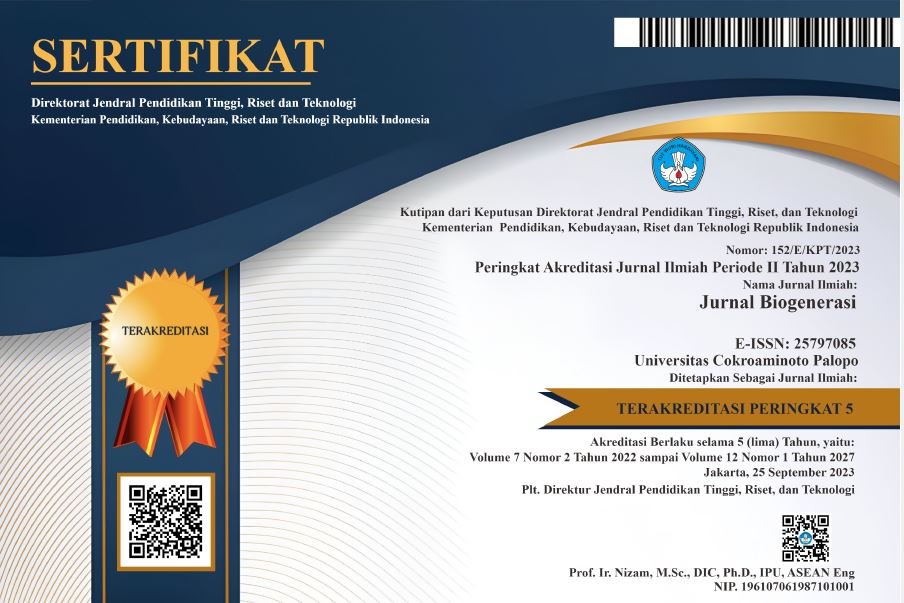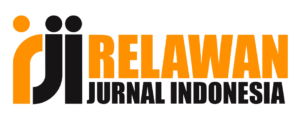THE DEVELOPMENT OF SCIENTIFIC BASED LKS ON ANIMAL AND PLANT TISSUES IN CLASS XI SCIENCE AT SMAN 10 GOWA
PENGEMBANGAN LKS BERBASIS SAINTIFIK PADA JARINGAN HEWAN DAN TUMBUHAN DI KELAS XI IPA SMAN 10 GOWA
DOI:
https://doi.org/10.30605/biogenerasi.v10i2.5462Keywords:
Student Worksheets, Scientific ApproachAbstract
This research aims to develop LKS based on a scientific approach to animal and plant tissue material for class XI Science at SMAN 10 Gowa, using the Dick & Carey development model so that the LKS is valid, practical and effective. The LKS development process follows seven modified stages, namely needs analysis, formulating specific objectives, developing instruments, developing strategies, developing LKS content, formative evaluation, and revision. The validation results from experts got a score of 3.5 which is included in the very good category, while the validation results from the class XI IPA2 biology teacher got a score of 3.35 in the very good category. Aspects assessed include introduction, appropriateness of content, appropriateness of presentation, appropriateness of language, and evaluation. Limited trials showed that students' responses to this worksheet obtained an average score of 73%, which was categorized as "effective". The results of learning observations showed a score of 3.5, which means this worksheet is classified as "practical". Based on these results, it can be concluded that the Biology LKS based on a scientific approach to animal and plant tissue material developed is suitable for use in learning trials for class XI Science with several revisions in accordance with the suggestions.
Downloads
References
2. Arikunto, S.,Dkk (2006). Penelitian Tindakan Kelas. Jakarta: PT Bumi Aksara Arifin (2011). Penelitian kualitatif, kuantitatif. Bandung:Alfabeta
3. Azhar, (1993). Lembar Kerja Siswa (LKS). Jakarta: PT.Raja Grafindo Persada
4. Dalla (2016), pengembangan lks menggunakan pendekatan saintifik pada Sub tema Hidup rukun di rumah untuk siswa kelas dua (II) Sekolah Dasar Negeri Kalasan I. Skripsi. Yogyakarta: Universitas Sanata Dharma.
5. Daryanto (2014). Pembelajaran tematik terpadu terintegrasi kurikulu 2013.
6. Yogyakarta: gava media
7. Depdiknas. (2004). Pendomaan umum pengembangan bahan ajar Sekolah Menengah Atas. Departemen Pendidikan Nasional, Direktorat Pendidikan Menegah Umum.
8. Dian Fitriana, dkk. (2016). Pengembangan Lembar Kerja Siswa. Fkip Universitas Sriwijaya
9. Dimyati & Mudjiono. (2006). Belajar dan pembelajaran. Jakarta: Rineka Cipta Depdiknas (2004). Pedomaan penyusunan lembar kerja siswa dan skenario
10. pembelajaran menengah atas. Jakarta: direktorat jendral pendidikan dasar
11. dan menengah
12. Gall dan Borg.(2007). Metode penelitian pendidikan. Bandung: PT. Remaja Rosdakarya
13. Hakim. T. (2000). Belajar Secara Efektif. Jakarta: Puspa Swara.
14. Hidayah & Sugiarto. (2006). Workshop pendidikan matematika. Semarang: fmipa unnes
15. Hosnan, M (2014). Pendekatan saintifik dan kontekstual dalam pembelajaran abad 21. Bogor: Ghalia Indonesia
16. Isnani, dkk (2020). Pengembangan lat bantu latihan smash
17. Jumali. (2007). Landasan pendidikan. Surakarta: Muhammadiyah University press.
18. Kemendikbud (2014). Pembelajaran pada pendidikan dasar dan pendidikan menengah
19. Kurniawan (2014). Pembelajaran terpadu tematik. Bandung. Alfabeta Kustandi (2015). Media pembelajaran manual. Semarang: Ghalia Indonesia
20. Lismawati. (2010). Penyusunan perangkat pembelajaran. Yogyakarta: Insan Madani
21. Mustofa. (2013). Pengembangan Lembar Kerja Siswa berbasis observasi pad ataman sekolah sebagai sunber belajar sains di SD N 1 Tinjomoyo. Skripsi. Semarang: Universitas Negeri Semarang.
22. Prastowo, A. (2014). Pengembangan bahan ajar tematik. Jakarta: Kencana Pratiwi. (2014). Pengembangan lembar kegiatan siswa berbasis pendekatan
23. saintifik pada tema berbagai pekerjaan dikelas IV. Skripsi. Bandung:
24. Universitas Pendidikan Indonesia
25. Putra. (2011).Resarch Dan Devolpment. Jakarta: Raja Grafindo Rustaman (2005). Strategi belajar mengajar biologi. Bandung:Upi perss
26. Setyosari, P. (2013). Metode penelitian pendidikan dan pengembangan. Jakarta: Kencana
27. Shalikhah, N. (2015). Pengembangan Lembar Kerja Siswa (LKS) Berbasis Pendekatan Scientific untuk melatih ketrampilan proses sains siswa SD/MI kelas IV. Tesis, tidak dipublikasikan. Yogyakarta: Universitas Sanat Dharma
28. Shelton, dkk (2008). Mengembangkan media pembelajaran. Jakarta: Gaung Persada Pers
29. Sukmadinata (2005). Metode penelitian pendidikan. Bandung: PT.Remaja Rosdakarya
30. Suyono & Heryanto (2011). Belajar dan pembelajaran teori dan konsep dasar.
31. Bandung: PT. Remaja Rosdakarya
32. Sudianti (2003). Tujuan lembar kerja. Bandung:Pustaka
33. Sugiyono (2009). Metode penelitian kualitatif penelitian pengembangan.
34. Bandung:alfabeta
35. Sukmadinata. (2005). Landasan Pesikologi Proses Pendidikan. Bandung: Pt.Remaja Rosdakarya
36. Trianto (2010). Model Pembelajaran Terpadu, konsep, strategi dan implementasinya dalam ktsp. Jakarta:bumi aksara
37. Widoyoko (2012). Teknik penyusunan instrmen penelitian. Yogyakarta: pustaka pelajar
Downloads
Published
How to Cite
Issue
Section
License
In submitting the manuscript to the journal, the authors certify that:
- They are authorized by their co-authors to enter into these arrangements.
- The work described has not been formally published before, except in the form of an abstract or as part of a published lecture, review, thesis, or overlay journal.
- That it is not under consideration for publication elsewhere,
- That its publication has been approved by all the author(s) and by the responsible authorities – tacitly or explicitly – of the institutes where the work has been carried out.
- They secure the right to reproduce any material that has already been published or copyrighted elsewhere.
- They agree to the following license and copyright agreement.
License and Copyright Agreement
Authors who publish with this journal agree to the following terms:
- Authors retain copyright and grant the journal right of first publication with the work simultaneously licensed under Creative Commons Attribution License (CC BY 4.0) that allows others to share the work with an acknowledgment of the work's authorship and initial publication in this journal.
- Authors are able to enter into separate, additional contractual arrangements for the non-exclusive distribution of the journal's published version of the work (e.g., post it to an institutional repository or publish it in a book), with an acknowledgment of its initial publication in this journal.
- Authors are permitted and encouraged to post their work online (e.g., in institutional repositories or on their website) prior to and during the submission process, as it can lead to productive exchanges, as well as earlier and greater citation of published work.


.png)

